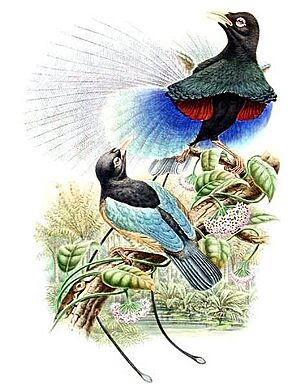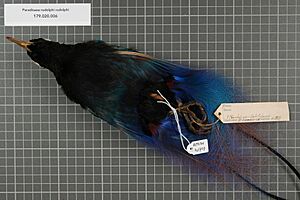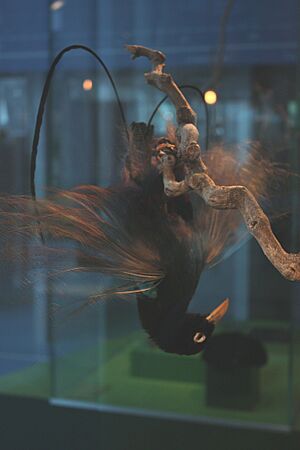Blue bird-of-paradise facts for kids
Quick facts for kids Blue bird-of-paradise |
|
|---|---|
 |
|
| Conservation status | |
| Scientific classification | |
| Genus: |
Paradisornis
|
| Species: |
rudolphi
|
 |
|
| Range of P. rudolphi | |
| Synonyms | |
|
|
The blue bird-of-paradise (Paradisornis rudolphi) is a really special and beautiful bird from the island of New Guinea. It's known for its amazing looks, especially the male birds, which have long, fancy feathers and tail wires. This bird is the only one in its group, called Paradisornis. People often say it's one of the most stunning birds in the world!
Contents
Discovering the Blue Bird-of-Paradise
The blue bird-of-paradise was first officially described in 1886. Two German scientists, Otto Finsch and Adolf Bernhard Meyer, gave it its scientific name. They called it Paradisornis rudolphi. The name Paradisornis means "paradise bird" in ancient Greek. The second part, rudolphi, honors Archduke Rudolf, who was the Crown-Prince of Austria.
There are two slightly different types, or subspecies, of the blue bird-of-paradise:
- P. r. margaritae found in east central New Guinea.
- P. r. rudolphi found in southeast New Guinea.
Sometimes, blue birds-of-paradise have even mixed with other bird-of-paradise species. They have created hybrid birds with the Lawes's parotia and the Raggiana bird-of-paradise.
What Does the Blue Bird-of-Paradise Look Like?
This bird is one of the larger birds-of-paradise. It measures about 30 centimeters (a little over a foot) long. This measurement does not include its very long tail wires.
Both male and female blue birds-of-paradise have shiny blue wings and tails. Their beaks are whitish or light gray. They also have silver-white crescent shapes around their eyes.
The Male's Amazing Features
The male blue bird-of-paradise is mostly glossy black. The back of his head has a reddish shine. His most amazing features are his long, silky flank feathers. These feathers are a dull amber color on top. Underneath, they are light blue with two dark red lines on each side of his lower belly.
He also has two very long, black tail wires. These wires can be up to 25 inches long! They have small, whitish tips. These special feathers help the male create a stunning display to attract females.
The Female's Appearance
The female looks similar to the male in some ways. She also has bright blue wings and tail feathers. However, she does not have the long, fancy flank plumes or the tail wires. Her underside is chestnut-brown with black stripes. Her head and neck are duller, with only a faint reddish shine.
How They Live: Behavior and Ecology
What Do They Eat?
Blue birds-of-paradise mostly eat fruit. They enjoy different kinds of fruits like figs, drupes, and berries. But they also eat small animals. Their diet includes insects and even some small reptiles.
They usually look for food alone. However, young birds and females might feed in trees with other birds. They search for fruits high up in the trees. When they hunt for animals, they look closer to the ground.
The Male's Special Dance
The male blue bird-of-paradise performs a truly amazing courtship display. Unlike many other birds-of-paradise, he does this dance alone on a thin branch. A female watches him nearby.
During his display, the male hangs upside down from the branch. He has a black oval with a red edge on his chest. This oval grows and shrinks rhythmically. His beautiful violet-blue feathers spread out like a fan, looking like an apron. He sways his body back and forth. His long black tail wires form two impressive arches around him. While dancing, he makes soft, buzzing sounds, mixed with chattering noises. These sounds help keep the female interested if she starts to move away.
Nesting and Raising Chicks
Only the female builds the nest and takes care of the babies. She uses stems, twigs, palm leaves, and vines to build a cup-shaped nest. She usually lays one egg, but sometimes two. The mother bird is very protective of her eggs and young. The eggs are a salmon color with reddish-brown spots around the ends.
Protecting the Blue Bird-of-Paradise
The blue bird-of-paradise is considered "Near Threatened" by the IUCN Red List. This means it could become endangered in the future. There are a few reasons for this:
- Habitat Loss: Their forest homes are being destroyed.
- Limited Range: They only live in a small area.
- Small Population: There aren't many of them left, estimated between 2,500 and 10,000 birds.
- Hunting: In some areas, they are hunted for their beautiful feathers.
Because of these threats, their numbers are decreasing. It's important to protect these amazing birds and their homes.
Gallery











